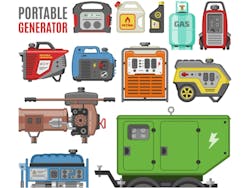A major opportunity exists for small, solar plus storage systems to replace gasoline or diesel backup generators that cause detriment to the environment worldwide, according to research funded by an arm of the World Bank Group.
Between 1 to 2 billion people do not have access to a reliable power grid, making back-up generation systems (BUGS) a popular alternative, especially in African countries such as Nigeria as well as the Americas and Asia, said Nicolas Lam, a research scientist at the Schatz Energy Research Center who presented the findings in an April 23 webinar.
Developing countries with inadequate electricity grids often have backup generation capacity that surpasses traditional grid-delivered power. Backup generators in Nigeria total 15 to 20 GW, while grid capacity is only 5 to 15 GW.
“If you can be famous for backup generators, Nigeria is famous for backup generators,” Lam said, adding that the West African country is the largest economy on the continent.
Lam and another project lead, Peter Alstone, have been studying the results of a model built by Schatz in 2019 to assess the use of backup generators globally. Lam’s work focuses on possible societal benefits of transitioning to clean energy in low- and middle-income countries. Alstone is studying distributed energy systems and energy access in off-grid environments.
In many countries, the grid lacks capacity to meet demand, creating inadequate electric supply or frequent power interruptions. This combination of factors forces many homes and businesses to use backup generators, often diesel, he said.
Backup generators beyond anecdote
The researchers hope that their work will lead to updates in pollutant inventories and more sophisticated analysis of the benefits of clean energy transitions. No systematic effort had been previously undertaken to measure the global, social and environmental impact of fossil fuel backup generators; knowledge tends to be anecdotal.
The research examines the quantity and size of backup generator systems, or BUGS, and the patterns of grid reliability that drive their use. It also looks at the amount of energy service provided, fuel burned, and the environmental and social costs.
“This isn’t all about BUGS, this is about clean electricity and clean transportation in general. But replacing BUGS is critical to maintaining good air quality in urban areas in many of the cities and places like the ones that we studied,” Alstone said.
In addition to increasing air and noise pollution, BUGS are costly. The researchers cited the report,“The Dirty Footprint of the Broken Grid,” that finds the operating cost, including capital costs, fuel and operation and maintenance of the tens of millions of backup generators around the world, especially in the Americas, Africa and Asia, is more than double the operating cost of grid electricity. The study puts the average service cost for backup generation at 30 cents/kWh for the fuel alone, with full cost of service at between 40 cents/kWh and several dollars/kWh.
“If you can be famous for backup generators, Nigeria is famous for backup generators.” — Lam
The installed capacity base of backup generation worldwide is estimated at 350-500 GW across 20 to 30 million individual sites. In West Africa, backup generator usage amounts to 40 percent of the electricity generated by the grid. Yet the energy sources are relatively expensive and inefficient compared to traditional power delivery, the report notes, and are a substantial contributor to environmental and health burdens. In sub-Saharan Africa, the nitrogen oxide emissions from the generators account for 15% of all such emissions in the region. In 38 of the countries that were modeled, including half of Sub-Saharan Africa, the installed capacity of such generators is greater than that of power plants connected to the grid.
How to boost solar plus storage
Solar plus storage alternatives can cost-effectively replace a lot of these sources but require “programmatic interventions and catalytic finance” in order to achieve that goal, according to the researchers. They suggest working with first-mover companies to innovate products and business models to replace fossil fuel-burning generation on a wide scale.
The Schatz study was conducted in partnership with the International Finance Corporation, a sister organization of the World Bank and member of the World Bank Group. The webinar was sponsored by Schatz Energy Research Center, the Environment & Community graduate program, and the College of Arts, Humanities & Social Sciences at Humboldt State.
Track news about solar plus storage microgrids. Subscribe to the free Microgrid Knowledge newsletter.







